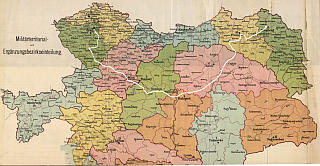
Švejk's journey on a of Austria-Hungary from 1914, showing the military districts of k.u.k. Heer. The entire plot of The Good Soldier Švejk is set on the territory of the former Dual Monarchy.
The Fateful Adventures of the Good Soldier Švejk (mostly known as The Good Soldier Švejk) by Jaroslav Hašek is a novel that contains a wealth of geographical references - either directly through the plot, in dialogues or in the author's narrative. Hašek was himself unusually well travelled and had a photographic memory of geographical (and other) details. It is evident that he put a lot of emphasis on geography: Eight of the 27 chapter headlines in the novel contain geographical names.
This web site will in due course contain a full overview of all the geographical references in the novel; from Prague in the introduction to Klimontów in the unfinished Part Four. Continents, states (also defunct), cities, market squares, city gates, regions, districts, towns, villages, mountains, mountain passes, oceans, lakes, rivers, caves, channels, islands, streets, parks and bridges are included.
The list is sorted according to the order in which the names appear in the novel. The chapter headlines are from Zenny Sadlon's recent translation (1999-2024) and will in most cases differ from Cecil Parrott's translation from 1973.
The quotes in Czech are copied from the on-line version of The Good Soldier Švejk: provided by Jaroslav Šerák and contain links to the relevant chapter. The toolbar has links for direct access to Wikipedia, Google maps, Google search, svejkmuseum.cz and the novel on-line.
The names are coloured according to their role in the novel, illustrated by these examples: Sanok a location where the plot takes place, Dubno mentioned in the narrative, Zagreb part of a dialogue, and Pakoměřice mentioned in an anecdote.
 Places index of countries, cities, villages, mountains, rivers, bridges ... (592)
Show all
Places index of countries, cities, villages, mountains, rivers, bridges ... (592)
Show all I. In the rear
I. In the rear  14. Švejk as military servant to senior lieutenant Lukáš (60)
14. Švejk as military servant to senior lieutenant Lukáš (60) II. At the front
II. At the front  2. Švejk's budějovická anabasis (64)
2. Švejk's budějovická anabasis (64) 3. Švejk's happenings in Királyhida (43)
3. Švejk's happenings in Királyhida (43) III. The famous thrashing
III. The famous thrashing  1. Across Magyaria (38)
1. Across Magyaria (38) 2. In Budapest (38)
2. In Budapest (38) 3. From Hatvan to the borders of Galicia (50)
3. From Hatvan to the borders of Galicia (50) 4. Forward March! (42)
4. Forward March! (42)



|
I. In the rear |
 | |
11. Švejk rides with the field chaplain to serve a field mass | |||
 | New Guinea |  | |||
| |||||
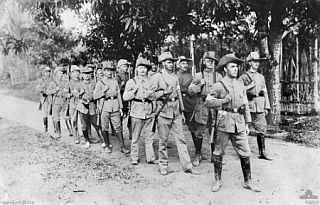
German reservists in New Guinea in 1914
New Guinea is mentioned by the author in connection with the religious rituals of cannibals, compared to current rituals related to the war. This is his introduction to Feldkurat Katz' og Švejk's field mass.
Background
New Guinea was by 1914 split between the Netherlands, the British Empire and Germany but Australian forces occupied the German part already in 1914.
New Guinea is the second largest island in the world and is located just north of Australia. Today the island is divided between Papua New Guinea and Indonesia.
Quote(s) from the novel
[I.11.1] Lidožrouti ostrovů Guinejských a Polynesie, než sežerou slavnostně své zajatce či lidi nepotřebné, jako misionáře, cestovatele a jednatele různých obchodních firem či prosté zvědavce, obětují předtím svým bohům, vykonávajíce nejrozmanitější náboženské výkony. Poněvadž k nim nepronikla ještě kultura ornátů, vyzdobují své hyždě věnci z pestrého péří lesního ptactva.
Also written:GuineaHašekNová GuineaczNeuguineade
Literature
 | Polynesia |  | |||
| |||||
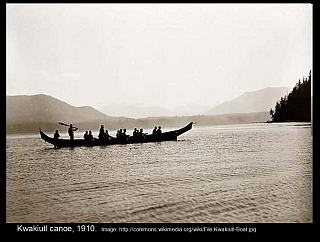
Polynesia is named when the author expands his opinion on religious rituals in connection with executions.
Background
Polynesia is a subregion of Oceania, made up of over 1,000 islands scattered over the central and southern Pacific Ocean. The term "Polynesia" was originally applied to all the islands of the Stillehavet. The only major political and geographical entity is New Zealand. The American state of Hawaii is also in Polynesia. The islands are partly independent, partly belonging to other states (USA, Chile, France and Australia). Until 1914 Germany was also present (Samoa).
Quote(s) from the novel
[I.11.1] Lidožrouti ostrovů Guinejských a Polynesie, než sežerou slavnostně své zajatce či lidi nepotřebné, jako misionáře, cestovatele a jednatele různých obchodních firem či prosté zvědavce, obětují předtím svým bohům, vykonávajíce nejrozmanitější náboženské výkony.
Also written:PolynésieczPolynesiendePolynésiefr
 | Spain |  | |||
| |||||

Spain is mentioned by the author when he tells about methods for executing people, and accompanying rituals where clerics take part. In this case there is talk "of a chair where the victim is strangled", certainly the garrote (el garrote). This execution device has been in use until present times, and not only in Spain.
The country was mentioned indirectly already in [I.2] through the term "the Spanish boot", an instrument of torture. Some geographical points in Spain also appear in the novel: Madrid, Toledo and Seville. Amongst historical figures Ignatius of Loyola is the only one referred to. Literary figures on the other hand are better represented: Don Quixote" class="autoref">Don Quijote, Sancho Panza and the still unidentified duque Almavira and his servant Fernando.
Background
Spain was in 1914 a kingdom and preserved its neutrality throughout the world war. Conflicts with Germany occurred because some Spanish ships were sunk, but there was never any armed action taken from the Spanish side.
Quote(s) from the novel
[I.11.1] V Prusku vodil pastor ubožáka pod sekyru, v Rakousku katolický kněz k šibenici, ve Francii pod gilotinu, v Americe kněz na elektrickou stolici, ve Španělsku na židli, kde byl důmyslným způsobem uškrcen, a v Rusku bradatý pop revolucionáře atd.
Also written:ŠpanělskoczSpaniendeEspañaes
 | Bremen |  | |||
| |||||
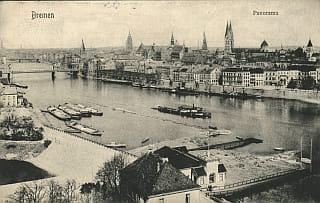
Bremen vor 1907
Bremen is mentioned by Švejk when tells Feldkurat Katz that he learned to make grog in Bremen. He was there on his wanderings a few years back. Bremen is one of the few places outside Bohemia that Švejk explicitly says he has visited.
Background
Bremen is a city and port in north west Germany, 60 km south of the mouth of the river Weser. During the times of Švejk it had status as a Freie Hansestadt (Free Hanseatic city).
Although Švejk says he has been to Bremen, there is no evidence that the author himself ever went there, so it is not clear what might have inspired this story. A possible source is Zdeněk Matěj Kuděj who traveled to New York from Cuxhaven on 17 March 1906 and may well have visited nearby Bremen on the way.
What Jaroslav Hašek no doubt was well informed about was the Bremer Räterepublik from early 1919, one of the two best known Soviet Republics on German territory. The revolutionary republic lasted for only one month.
Quote(s) from the novel
[I.11.2] „Když jsem před léty vandroval,“ odpověděl Švejk, „v Brémách od jednoho zpustlýho námořníka, který říkal, že grog musí být tak silný, aby, když někdo spadne do moře, přeplaval celej kanál La Manche. Po slabým grogu se utopí jako štěně.“
Also written:Brémycz
 | English Channel |  | |||
| |||||
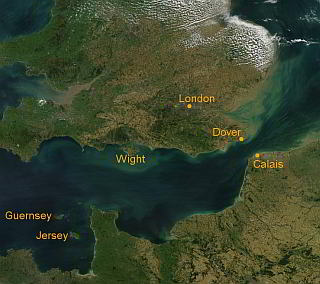
English Channel is mentioned when Švejk tells Feldkurat Katz that grog must be so string that one can swim across the Channel with one a these inside.
Background
English Channel is a strip of sea that separates England and France. It is part of the Atlantic Ocean, and connects this to the North Sea. The channel is at its narrowest between Dover and Calais where it is 34 km wide.
Quote(s) from the novel
[I.11.2] „Když jsem před léty vandroval,“ odpověděl Švejk, „v Brémách od jednoho zpustlýho námořníka, který říkal, že grog musí být tak silný, aby, když někdo spadne do moře, přeplaval celej kanál La Manche. Po slabým grogu se utopí jako štěně.“
Also written:Kanál La mancheczÄrmelkanaldeLa ManchefrEngelske kanalennn
 | Mödling |  | |||
| |||||
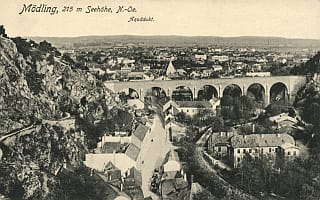
Mödling, Aquädukt, 1913
Mödling is mentioned by the author in connection with the race Vienna - Mödling where Oberleutnant Witinger had won the cup that Feldkurat Katz used as a chalice at the field mass. Witinger reportedly ran 40 km in 1 hour 48 minutes.
Background
Mödling is a town in Niederösterreich, with a population number (in 2007) of around 21,000. The town is situated 16 kilometres south of Vienna and is often called Perle des Wienerwaldes.
Oberleutnant Witinger allegedly ran 40 km in 1 hours 48 minutes which suggests that the author didn't care much about numbers. The marathon (41,185 metres) world record per 2016 is 2.02.57 and was claimed by Dennis Kimetto in Berlin in 2014. This is the first example in The Good Soldier Švejk of the author's disregard for chronological accuracy. Obviously Jaroslav Hašek could also have got the distance wrong, the actual distance between the towns (16 km) would be possible to run in 1h 48.
That said, it may be that the author was perfectly aware of the distances and times involved and that he was simply making fun of the boastful Oberleutnant Witinger.
Demography
According to the 1910 census Mödling had 18 067 inhabitants. The judicial district was Gerichtsbezirk Mödling, administratively it reported to Bezirkshauptmannschaft Mödling.
Military
Per the recruitment districts, infantrymen from Mödling were usually assigned to Infanterieregiment Nr. 84 (Wien) or k.k. Landwehrinfanterieregiment Nr. 21 (Sankt Pölten).
Quote(s) from the novel
[I.11.2] Tak dostaneme sportovní pohár od nadporučíka Witingra od 75. pluku. On kdysi před lety běhal o závod a vyhrál jej za ,Sport-Favorit’. Byl to dobrý běžec. Dělal čtyřicet kilometrů Vídeň-Mödling za 1 hodinu 48 minut, jak se nám vždycky chlubí. Jsem hovado, že všechno odkládám na poslední chvíli. Proč jsem se, trouba, nepodíval do té pohovky.“
[I.11.2] Konečně se ozvalo „Zum Gebet!“, zavířilo to prachem a šedivý čtverec uniforem sklonil svá kolena před sportovním kalichem nadporučíka Witingra, který on vyhrál za Sport-Favorit v běhu Vídeň-Mödling.
 | Zhoř |  | |||
| |||||
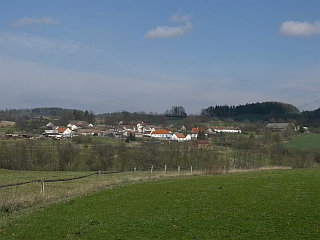
Zhoř by Písek
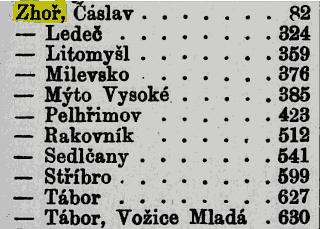
Liste over stader i Böhmen, 1913
Zhoř is mentioned in an anecdote Švejk tells the priest in Vršovice, where he implicitly threatens with the worst if the field altar, the property of the army, doesn't appear again.
A place with such a name is mentioned again in the story about Špatina in [III.2] but may not be the same place.
Background
Zhoř is the name of several places in Bohemia and Moravia. The author has surely been aware of most of these, so it's anybody's guess which one he has in mind. It should still be assumed that it is from an area he knew well, for instance Vysočina or South Bohemia.
In the list of places in Bohemia from 1913 the Zhoř appears now less than 11 times[a]. They were all small places, the largest being in okres Pacov, hejtmanství Pelhřimov, with 622 inhabitants. I Moravia there are also several, one of them by Jihlava.
Quote(s) from the novel
[I.11.2] Jeden člověk ve Zhoři taky vyoral nějakej kalich na poli, kterej pocházel ze svatokrádeže a byl tam schovanej na lepší doby, až se na to zapomene, a považoval to taky za pokyn boží a šel, místo aby jej rozšmelcoval, k panu faráři s tím kalichem, že prý ho chce darovat kostelu.
[III.2] „Poslušně hlásím, pane obrlajtnant“ řekl s obvyklou ohebností Švejk, „věc, o kterou jde, je nesmírně důležitou. Prosil bych, pane obrlajtnant, abychom mohli tu celou záležitost vyřídit někde vedle, jako říkal jeden můj kamarád, Špatina ze Zhoře, když dělal svědka na svatbě a chtělo se mu najednou v kostele...“
Literature
- Seznam míst v království Českém, ,1913 [a]
| a | Seznam míst v království Českém | 1913 |
 | Chotěboř |  | ||||
| ||||||
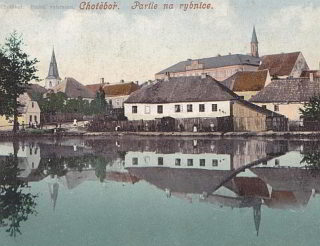
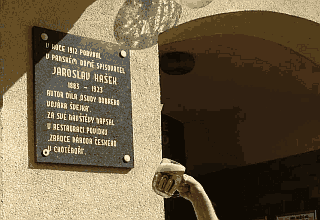
Panský dům. Fotografie László Polgár
Chotěboř is mentioned in Švejk's conversation with the priest in Vršovice, relating to a certain Pivoňka.
Background
Chotěboř is a town in Vysočina with 9,633 inhabitants (2011). It is located 14 km north east of Havlíčkův Brod and belongs to the district of that same name.
Hašek in Chotěboř
Jaroslav Hašek visited Chotěboř in the summer of 1912 and this stay no doubt inspired the story The traitor of the nation in Chotěboř[a]. The author stayed at Panský dům and the building boasts a memorial plaque in his honour.
Demography
According to the 1910 census Chotěboř had 4,481 inhabitants of whom 4,472 (99 per cent) reported using Czech in their daily speech. The judicial district was okres Chotěboř, administratively it reported to hejtmanství Chotěboř.
Source:Seznam míst v království Českém(1913)
Military
Per the recruitment districts, infantrymen from Chotěboř were usually assigned to Infanterieregiment Nr. 21 (Časlau) or k.k. Landwehrinfanterieregiment Nr. 30 (Hohenmauth).
Quote(s) from the novel
[I.11.2] Nějakej Pivoňka z Chotěboře považoval jednou také za boží řízení, když se mu do rukou připletla ohlávka s cizí krávou.
Credit: František Drašner, Radko Pytlík, László Polgár
Literature
- Zrádce národa v Chotěboři, Jaroslav Hašek,10.10.1912 [a]
- Z potulek po Čechách, Jaroslav Hašek,31.10.1913
- Historie, současnost, údolí Doubravy,
- Švejkův místopis: Lipnice, Chotěboř, Brod..., ,10.3.2011
- Jaroslav Hašek na Vysočině, ,2014
| a | Zrádce národa v Chotěboři | Jaroslav Hašek | 10.10.1912 |
 | Zambezi |  | |||
| |||||
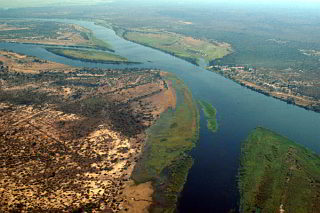
Zambezi is mentioned in the author's description of the field altar, which just as well could have been used by pagans from that area.
Background
Zambezi is Africa's fourth longest river and flows from west to east in the southern part of Africa.
Quote(s) from the novel
[I.11.2] Nebylo také možno zjistit bez fantasie, co vlastně představují obrazy namalované na těch třech dílech. Jisto je, že to byl oltář, kterého by mohli stejně používat nějací pohani na Zambezi či šamáni Burjatů i Mongolů.
Also written:Sambeside
 | Buryatia |  | |||
| |||||
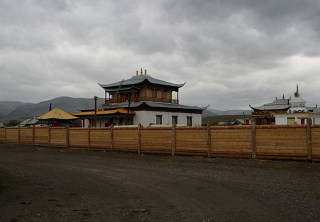
Gusinoye Ozero (Гусиное Озеро), 2010
Buryatia is mentioned in the authors description of the field altar which according to him just as well could have been used by Buryat and Mongol shamans.
Background
Buryatia is an autonomous republic in Siberia between Baikal-sjøen and Mongolia. The Burjats is a people of mongolian descent, no in a minority in the republic. In 1923 Buryatia became an autonomous Soviet republic (ASSR). The capital is Ulan-Ude and the Trans-siberian railway goes through the republic.
In 1920 Jaroslav Hašek ran propaganda activities amongst the Burjats and even taught himself some of the language. It is proven that he visited the region and at least got as far as Гусиное Озеро (Gusinoye Ozero), close to the Mongolian border.
Quote(s) from the novel
[I.11.2] Nebylo také možno zjistit bez fantasie, co vlastně představují obrazy namalované na těch třech dílech. Jisto je, že to byl oltář, kterého by mohli stejně používat nějací pohani na Zambezi či šamáni Burjatů i Mongolů.
Credit: Pavel Gan
Also written:Буряад РеспубликаbuBurjatskoczBurjatiendeРеспублика Бурятияru
 | Mongolia |  | |||
| |||||
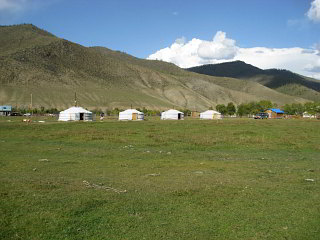
Gers in Songal, Northern Mongolia, 2007
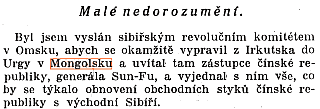
Pepíček Nový a jiné povídky, ,1921
Mongolia is mentioned by Jaroslav Hašek in his description of the field altar "that just as well could have meen used by Buryatian and Mongolian shamans".
Background
Mongolia is a republic in Asia between Russia and China that broke away from China in 1911. During the Russian civil war Mongolia changed hands several time, but from 1921 the communists led by Damdin Sükhbaatar got the upper hand, something that led to nearly 70 years of communist rule and strong links to the Soviet Union. A legacy from this period is the use of the Cyrillic alphabet.
Hašek and Mongolia
In 1920 Jaroslav Hašek was involved on the periphery of the political struggle for Mongolia and he indeed knew Sükhbaatar in person. In the story Malé nedorozumění (Small misunderstandings)[a] he writes that he travelled all the way to Urga (now Ulaanbaatar). This story has not been verified and is surely an example of "mystifikace". Such a journey during the short time he stayed in Irkutsk would in 1920 have been practically impossible.
Quote(s) from the novel
[I.11.2] Nebylo také možno zjistit bez fantasie, co vlastně představují obrazy namalované na těch třech dílech. Jisto je, že to byl oltář, kterého by mohli stejně používat nějací pohani na Zambezi či šamáni Burjatů i Mongolů.
Credit: Pavel Gan
Also written:MongolskoczMongoleideМонгол УлсmnМонголияru
Literature
- Malé nedorozumění, ,1921 [a]
| a | Malé nedorozumění | 1921 |
 | Wyandotte |  | ||||
| ||||||
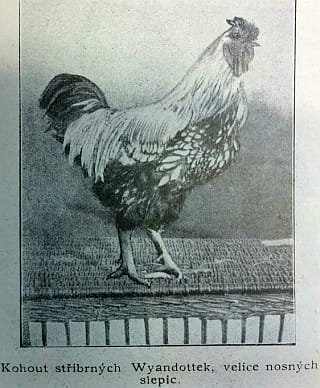
,1.2.1909
Wyandotte is mentioned indirectly through the Wyandotte chicken who cackle themselves into the plot twice. First when the author describes the altar that Feldkurat Katz uses for his field mass, here through the white Wyandotte hen.
The second instance occurs when Einjährigfreiwilliger Marek tells about his unfortunate experiences as editor of Svět zvířat. During the interview Fuchs offered him a pair of mini Wyandottes who had won first price at a poultry exhibition in Berlin.
Background
Wyandotte is the name of several places in the US, but the name of this chicken breed is taken from the Huron tribe who also call themselves Wyandotte. The tribal headquarters are located in Wyandotte, Oklahoma.
The breed of chicken was officially recognised in 1883 and borrowed the name from the above-mentioned Indian tribe. In Europe a midget-variation was bred later.
Jaroslav Hašek obviously knew about this animal breed (and many others) from his time as editor of Svět zvířat in 1909 and 1910. During his time as an editor the magazine printed some stories about "wyandottek" and photos also appeared.
Quote(s) from the novel
[I.11] Namaloval nějakého ptáka, který mohl být stejně holubicí jako slepicí bílých wyandotek.
[II.3] Opět mne přerušil a řekl, že mu to úplně stačí, a jestli jen polovičku toho podaří se mně splnit, že mně daruje párek trpasličích wyandotek z poslední berlínské výstavy drůbeže, které obdržely první cenu a majitel zlatou medalii za výborné spáření.
 | Posázaví |  | |||
| |||||

View from Lipnice across the Sázava valley, 8.9.2009
Posázaví is mentioned by the author when he describes the field altar and where he compares some of its motives with the landscape by the Sázava.
Background
Posázaví is a region in the Vysočina region, and is the name of the area by the river Sázava. The river flows from east to west, the source is the lake Velké Dářko and it flows into the Vltava by Davle south of Prague.
This was an area Jaroslav Hašek knew very well from the time he lived in Lipnice, near the upper part of the river valley.
Quote(s) from the novel
[I.11.2] Vojáci se vždy hádali a luštili ten rebus. Někdo myslel dokonce, že je to krajinka z Posázaví.
Literature
- Jaroslav Hašek na Vysočině, ,2014



|
I. In the rear |
 | |
11. Švejk rides with the field chaplain to serve a field mass | |||
| © 2008 - 2024 Jomar Hønsi | Last updated: 22.10.2024 |


